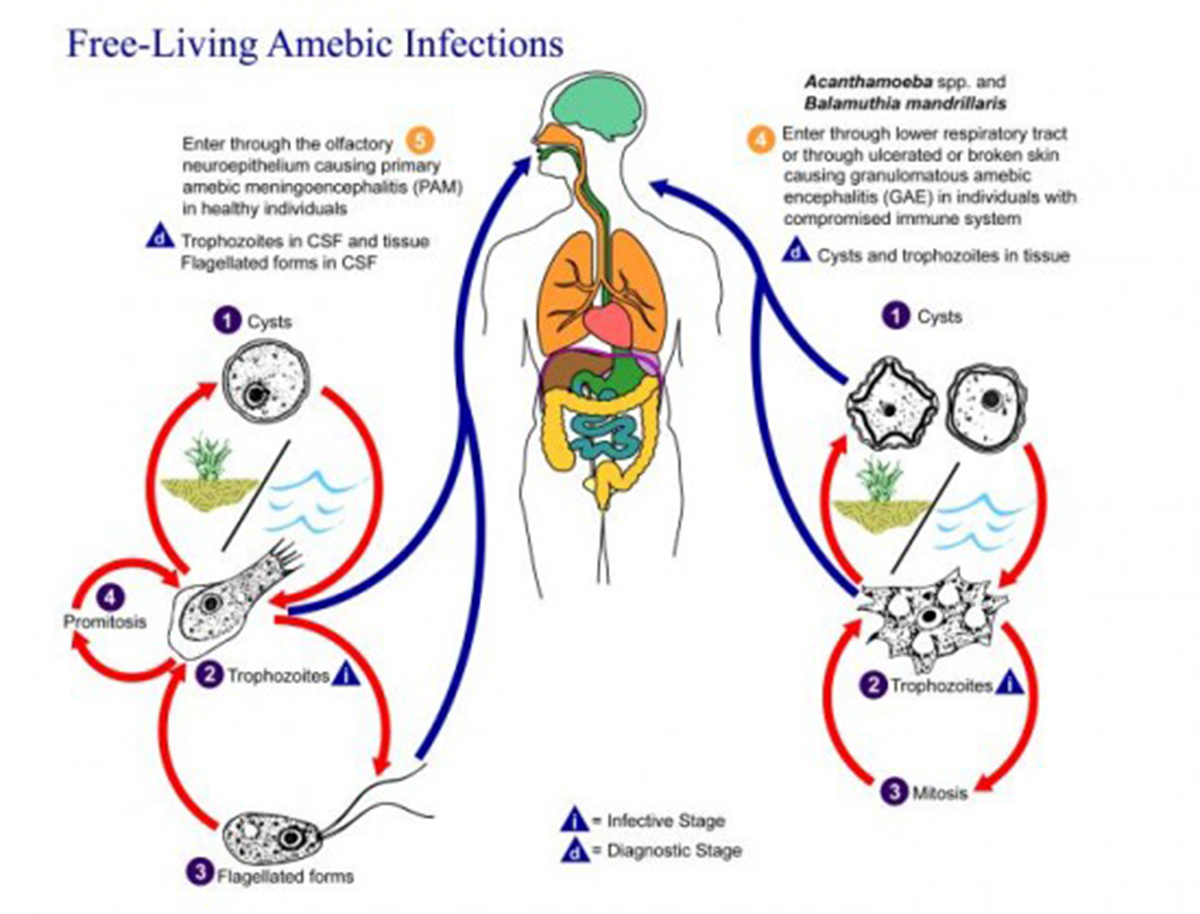Table of Contents
What is Amoebic Meningoencephalitis?
Amoebic meningoencephalitis often referred to as Primary Amoebic Meningoencephalitis (PAM)is a medical condition affecting the brain and is characterized by the inflammation of the brain followed by a destruction of the brain and the linings of the brain.

Though there are numerous species of Naegleria, not all of them are deadly. Naegleria is commonly found in fresh water lakes, ponds, hot springs, and rivers. Amoebic meningoencephalitis that is caused by Naegleria fowleri can be fatal. People typically get infected by Naegleria fowleri when contaminated water enters their body through their nose. This can happen when people are swimming or diving in warm fresh water lakes or ponds.
Naegleria fowleri and the earliest cases of amoebic meningoencephalitis were reported in the 1960s in Australia. Since then, numerous countries have reported instances of amoebic meningoencephalitis caused by Naegleria fowleri. The most common victims of amoebic meningoencephalitis are children who are unaware of the dangers associated with swimming in fresh, unclean water.
Who gets infected by Amoebic meningoencephalitis?
The ideal thriving conditions for Naegleria fowleri are presence of water and temperatures ranging between 28 to 50ºC. Warm, fresh water bodies including lakes, rivers, geothermal water in the form of hot springs, and warm water discharge from industrial plants are some of the places where Naegleria fowleri can thrive.
It is important to note that Naegleria fowleri cannot thrive in any water body that has more than two percent salt. Examples of such water bodies include river estuaries and sea water.
Amoebic meningoencephalitis happens when water infected with Naegleria fowleri enters the nose when a person indulges in water-related activities. After entering the nose, the amoeba travels up to the brain and the central nervous system and causes the primary amoebic meningoencephalitis. Naegleria fowleri travels up to the brain through the olfactory nerve.
PAM is a rare disease but in most of the cases, it is fatal. It must be noted that PAM is not caused by drinking infected water. It is also important to note that there has never been any report of spread of infection from one person to the other. Even in cases involving transplantation of organs from donors who are infected with Naegleria fowleri, the recipients has never been infected. However, recent studies have also shown the presence of Naegleria fowleri outside the brain. Therefore, the risks associated while transplanting organs from Naegleria fowleri infected people cannot be totally overruled.
Read More: Meningococcal Disease: Meningitis treatment and prevention
The first reported occurrence of amoebic meningoencephalitis in the US was in 1962 in Florida. Infections have also been reported in the Southern-tier states of the US and most cases of amoebic meningoencephalitis have been caused by swimming in warm freshwater rivers and lakes. Most cases of amoebic meningoencephalitis have been reported in children less than 18 years of age.
The risk of infection from Naegleria fowleri is the highest during the months of July and August when water levels are low and water temperatures are at the maximum.
- “Primary Amoebic Meningoencephalitis in Britain”, by W. St. C. Symmers. Published in the November 22, 1969 issue of the British Medical Journal, accessed on November 25, 2013
- “Primary amoebic meningoencephalitis with Naegleria fowleri: Clinical review” by Nancy D.P. Barnett, et al. Published in the Volume 15, Issue 3, October 1996 of Pediatric Neurology, accessed on November 25, 2013.
- Photo courtesy of CDC/Alexander J. da Silva, PhD/Melanie Moser by Centers for Disease Control and Prevention's Public Health Image Library : phil.cdc.gov/phil/details.asp?pid=3412
- Photo courtesy of Raziel by Wikimedia Commons : en.wikipedia.org/wiki/File:M%C3%A9ningo-enc%C3%A9phalite_amibienne_primitive.JPG


Your thoughts on this